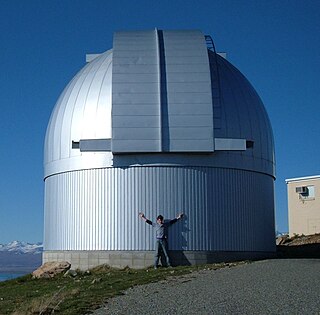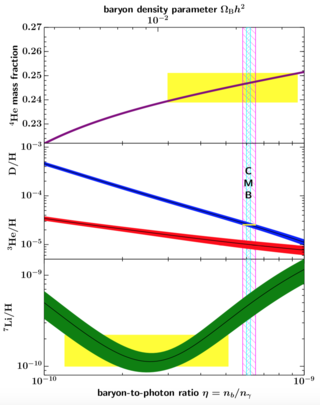Related Research Articles
In astronomy, dark matter is a hypothetical form of matter that appears not to interact with light or the electromagnetic field. Dark matter is implied by gravitational effects which cannot be explained by general relativity unless more matter is present than can be seen. Such effects occur in the context of formation and evolution of galaxies, gravitational lensing, the observable universe's current structure, mass position in galactic collisions, the motion of galaxies within galaxy clusters, and cosmic microwave background anisotropies.
The study of galaxy formation and evolution is concerned with the processes that formed a heterogeneous universe from a homogeneous beginning, the formation of the first galaxies, the way galaxies change over time, and the processes that have generated the variety of structures observed in nearby galaxies. Galaxy formation is hypothesized to occur from structure formation theories, as a result of tiny quantum fluctuations in the aftermath of the Big Bang. The simplest model in general agreement with observed phenomena is the Lambda-CDM model—that is, that clustering and merging allows galaxies to accumulate mass, determining both their shape and structure. Hydrodynamics simulation, which simulates both baryons and dark matter, is widely used to study galaxy formation and evolution.

A molecular cloud, sometimes called a stellar nursery (if star formation is occurring within), is a type of interstellar cloud, the density and size of which permit absorption nebulae, the formation of molecules (most commonly molecular hydrogen, H2), and the formation of H II regions. This is in contrast to other areas of the interstellar medium that contain predominantly ionized gas.

Star formation is the process by which dense regions within molecular clouds in interstellar space, sometimes referred to as "stellar nurseries" or "star-forming regions", collapse and form stars. As a branch of astronomy, star formation includes the study of the interstellar medium (ISM) and giant molecular clouds (GMC) as precursors to the star formation process, and the study of protostars and young stellar objects as its immediate products. It is closely related to planet formation, another branch of astronomy. Star formation theory, as well as accounting for the formation of a single star, must also account for the statistics of binary stars and the initial mass function. Most stars do not form in isolation but as part of a group of stars referred as star clusters or stellar associations.
In cosmology and physics, cold dark matter (CDM) is a hypothetical type of dark matter. According to the current standard model of cosmology, Lambda-CDM model, approximately 27% of the universe is dark matter and 68% is dark energy, with only a small fraction being the ordinary baryonic matter that composes stars, planets, and living organisms. Cold refers to the fact that the dark matter moves slowly compared to the speed of light, giving it a vanishing equation of state. Dark indicates that it interacts very weakly with ordinary matter and electromagnetic radiation. Proposed candidates for CDM include weakly interacting massive particles, primordial black holes, and axions.

A stellar black hole is a black hole formed by the gravitational collapse of a star. They have masses ranging from about 5 to several tens of solar masses. The process is observed as a hypernova explosion or as a gamma ray burst. These black holes are also referred to as collapsars.

A rogueplanet, also termed a free-floating planet (FFP) or an isolated planetary-mass object (iPMO), is an interstellar object of planetary mass which is not gravitationally bound to any star or brown dwarf.
Photoevaporation denotes the process where energetic radiation ionises gas and causes it to disperse away from the ionising source. This typically refers to an astrophysical context where ultraviolet radiation from hot stars acts on clouds of material such as molecular clouds, protoplanetary disks, or planetary atmospheres.
The Lambda-CDM, Lambda cold dark matter or ΛCDM model is a mathematical model of the Big Bang theory with three major components:
- a cosmological constant denoted by lambda (Λ) associated with dark energy,
- the postulated cold dark matter, and
- ordinary matter.

Gravitational microlensing is an astronomical phenomenon due to the gravitational lens effect. It can be used to detect objects that range from the mass of a planet to the mass of a star, regardless of the light they emit. Typically, astronomers can only detect bright objects that emit much light (stars) or large objects that block background light. These objects make up only a minor portion of the mass of a galaxy. Microlensing allows the study of objects that emit little or no light.

A satellite galaxy is a smaller companion galaxy that travels on bound orbits within the gravitational potential of a more massive and luminous host galaxy. Satellite galaxies and their constituents are bound to their host galaxy, in the same way that planets within our own solar system are gravitationally bound to the Sun. While most satellite galaxies are dwarf galaxies, satellite galaxies of large galaxy clusters can be much more massive. The Milky Way is orbited by about fifty satellite galaxies, the largest of which is the Large Magellanic Cloud.

Microlensing Observations in Astrophysics (MOA) is a collaborative project between researchers in New Zealand and Japan, led by Professor Yasushi Muraki of Nagoya University. They use microlensing to observe dark matter, extra-solar planets, and stellar atmospheres from the Southern Hemisphere. The group concentrates especially on the detection and observation of gravitational microlensing events of high magnification, of order 100 or more, as these provide the greatest sensitivity to extrasolar planets. They work with other groups in Australia, the United States and elsewhere. Observations are conducted at New Zealand's Mt. John University Observatory using a 1.8 m (70.9 in) reflector telescope built for the project.

The Dark Energy Survey (DES) is an astronomical survey designed to constrain the properties of dark energy. It uses images taken in the near-ultraviolet, visible, and near-infrared to measure the expansion of the universe using Type Ia supernovae, baryon acoustic oscillations, the number of galaxy clusters, and weak gravitational lensing. The collaboration is composed of research institutions and universities from the United States, Australia, Brazil, the United Kingdom, Germany, Spain, and Switzerland. The collaboration is divided into several scientific working groups. The director of DES is Josh Frieman.
Modified Newtonian dynamics (MOND) is a hypothesis that proposes a modification of Newton's second law to account for observed properties of galaxies. It is an alternative to the hypothesis of dark matter in terms of explaining why galaxies do not appear to obey the currently understood laws of physics.

In cosmology, primordial black holes (PBHs) are hypothetical black holes that formed soon after the Big Bang. In the inflationary era and early radiation-dominated universe, extremely dense pockets of subatomic matter may have been tightly packed to the point of gravitational collapse, creating primordial black holes without the supernova compression needed to make black holes today. Because the creation of primordial black holes would pre-date the first stars, they are not limited to the narrow mass range of stellar black holes.

A planetary-mass object (PMO), planemo, or planetary body is, by geophysical definition of celestial objects, any celestial object massive enough to achieve hydrostatic equilibrium, but not enough to sustain core fusion like a star.
In planetary science a streaming instability is a hypothetical mechanism for the formation of planetesimals in which the drag felt by solid particles orbiting in a gas disk leads to their spontaneous concentration into clumps which can gravitationally collapse. Small initial clumps increase the orbital velocity of the gas, slowing radial drift locally, leading to their growth as they are joined by faster drifting isolated particles. Massive filaments form that reach densities sufficient for the gravitational collapse into planetesimals the size of large asteroids, bypassing a number of barriers to the traditional formation mechanisms. The formation of streaming instabilities requires solids that are moderately coupled to the gas and a local solid to gas ratio of one or greater. The growth of solids large enough to become moderately coupled to the gas is more likely outside the ice line and in regions with limited turbulence. An initial concentration of solids with respect to the gas is necessary to suppress turbulence sufficiently to allow the solid to gas ratio to reach greater than one at the mid-plane. A wide variety of mechanisms to selectively remove gas or to concentrate solids have been proposed. In the inner Solar System the formation of streaming instabilities requires a greater initial concentration of solids or the growth of solid beyond the size of chondrules.
In cosmology, the missing baryon problem is an observed discrepancy between the amount of baryonic matter detected from shortly after the Big Bang and from more recent epochs. Observations of the cosmic microwave background and Big Bang nucleosynthesis studies have set constraints on the abundance of baryons in the early universe, finding that baryonic matter accounts for approximately 4.8% of the energy contents of the Universe. At the same time, a census of baryons in the recent observable universe has found that observed baryonic matter accounts for less than half of that amount. This discrepancy is commonly known as the missing baryon problem. The missing baryon problem is different from the dark matter problem, which is non-baryonic in nature.

In astronomy, the lithium problem or lithium discrepancy refers to the discrepancy between the primordial abundance of lithium as inferred from observations of metal-poor halo stars in our galaxy and the amount that should theoretically exist due to Big Bang nucleosynthesis+WMAP cosmic baryon density predictions of the CMB. Namely, the most widely accepted models of the Big Bang suggest that three times as much primordial lithium, in particular lithium-7, should exist. This contrasts with the observed abundance of isotopes of hydrogen and helium that are consistent with predictions. The discrepancy is highlighted in a so-called "Schramm plot", named in honor of astrophysicist David Schramm, which depicts these primordial abundances as a function of cosmic baryon content from standard BBN predictions.
The GRSI model is an attempt to explain astrophysical and cosmological observations without dark matter, dark energy or modifying the laws of gravity as they are currently established. This model is an alternative to Lambda-CDM, the standard model of cosmology.
References
- 1 2 Barnes, Rory (2011), "Gravitational Focusing", in Gargaud, Muriel; Amils, Ricardo; Quintanilla, José Cernicharo; Cleaves, Henderson James (Jim) (eds.), Encyclopedia of Astrobiology, Berlin, Heidelberg: Springer, p. 692, doi:10.1007/978-3-642-11274-4_670, ISBN 978-3-642-11274-4 , retrieved 2023-01-01
- ↑ Sofue, Yoshiaki (June 2020). "Gravitational Focusing of Low-Velocity Dark Matter on the Earth's Surface". Galaxies. 8 (2): 42. arXiv: 2005.08252 . doi: 10.3390/galaxies8020042 . ISSN 2075-4434.
- ↑ Kuznetsova, Aleksandra; Hartmann, Lee; Burkert, Andreas (2017-02-21). "Gravitational Focusing and the Star Cluster Initial Mass Function". The Astrophysical Journal. 836 (2): 190. arXiv: 1702.00279 . doi: 10.3847/1538-4357/aa5d51 . ISSN 1538-4357. S2CID 119484707.
- ↑ Kim, Hyungjin; Lenoci, Alessandro (2022-03-31). "Gravitational focusing of wave dark matter". Physical Review D. 105 (6): 063032. doi: 10.1103/PhysRevD.105.063032 . S2CID 245117706.